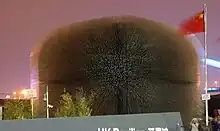UK pavilion at Expo 2010
The UK pavilion at Expo 2010, colloquially known as the Seed Cathedral, was a sculpture structure built for the 2010 World Expo in Shanghai by a nine-member conglomerate of British business and government resources directed by designer Thomas Heatherwick. Referencing the race to save plant seeds from round the world in banks, it housed 250,000 seeds at the ends of 60,000 acrylic fibre-optic filaments which projected both outside and inside the building.

Design

The pavilion's architecture was an elaboration of Heatherwick's 2003 work Sitooterie II in Essex. Heatherwick conceived it as embodying what it exhibited and presenting a unique contrast with the norm of technology-focussed exposition pavilions. A rounded cuboid[1] 20 metres (66 ft) high, it was placed in the centre of the 6,000 square metres (65,000 sq ft) United Kingdom exhibit site, so that visitors could choose whether to go inside or contemplate it from a distance. The grounds were landscaped with artificial turf; the pavilion entrance and exit and space for exhibits on the environment were located under the grounds and on an underground level of the pavilion.[2]
The structure consisted of a steel and timber composite frame 1 metre thick with precision-drilled holes in which 60,000 fiber-optic filaments, 7.5 metres (25 ft) long and 20 millimetres (0.79 in) square in section, were held in aluminium sleeves. The filaments protruded both on the outside, where they rippled in the wind, and on the inside, where each displayed one or more seeds at its tip. The seeds were sourced from the Kunming Institute of Botany, a partner in Kew Gardens' Millennium Seed Bank Project, which the pavilion was designed to showcase. The interior was lighted during the day by light drawn in by the filaments; after dark, the building was illuminated from within by light sources in the filaments.[2][3]
History
Heatherwick won the contest held in 2007 by the Foreign & Commonwealth Office to design the pavilion, responding to the brief that it should be one of the five most popular attractions at the exposition.[2] The original concept was a "Pavilion of Ideas", with programmable light sources at the ends of the spines, presenting concepts from presentations in the pavilion and from vistor suggestions.[4] Heatherwick later developed this into an exploration of the relationship between cities and nature, in keeping with the Expo 2010 theme, "Better City, Better Life".[2]

Constructed at a cost of £26 million,[5] the UK pavilion was one of the most popular pavilions prior to the opening, and was given the Chinese nickname "the dandelion", a symbol of good luck.[3][6] As of July 2010, it was attracting 50,000 people a day.[7] It won the gold award of the Bureau International des Expositions for best pavilion design in its size category[8] and the RIBA Lubetkin Prize for the best building outside the European Union.[7]
After the exposition, the pavilion was dismantled as planned despite offers to buy it and reassemble it elsewhere.[5] The seed-containing rods were originally to have been donated to schools.[2][5][9] Some were donated to botanical institutions in the United Kingdom and China, and others given to heads of state and other dignitaries who had visited the pavilion. Most, including 10 signed by Prime Minister David Cameron, were auctioned on Taobao beginning in October 2010; 2.63 million yuan from the auction proceeds was donated to Shanghai Cerecare, a charity supporting children with brain paralysis. In January 2011, Taobao gave the auction its top award.[10]
References
- Chris Hogg (9 March 2010). "Inside World Expo 'Seed Cathedral'". BBC News (video).
- Jordana, Sebastian (3 May 2010). "UK Pavilion for Shanghai World Expo 2010 / Heatherwick Studio". ArchDaily. Retrieved 14 February 2023.
- Leonora Oppenheim (27 April 2010). "Awe Inspiring Seed Cathedral Wows at Shanghai World Expo 2010 (Photos)". Treehugger. Archived from the original on 30 April 2010.
- Marcus Fairs (21 September 2007). "Thomas Heatherwick wins British Shanghai Expo Pavilion competition". Dezeen. Retrieved 14 February 2023.
- Richard Waite (2 September 2010). "Shanghai 2010: 'Seed cathedral' will not be sold says FCO". Architects' Journal. Retrieved 14 February 2023.
- Marcus Fairs (4 April 2010). "UK Pavilion at Shanghai Expo 2010 by Thomas Heatherwick". Dezeen. Retrieved 14 February 2023.
- "London, UK – Heatherwick Studio's British Pavilion wins the Lubetkin Prize". The Architectural Review. 27 July 2010. Retrieved 14 February 2023.
- "BIE Day at EXPO 2010". Bureau International des Expositions. 30 October 2010. Archived from the original on 8 November 2010.
- Yuka Yoneda (5 April 2010). "Construction Complete on the UK's Stunning Seed Cathedral". Inhabitat. Retrieved 14 February 2023.
- "Cathedral seeds best-seller on Taobao website". ChinaDaily. 30 January 2011. Retrieved 14 February 2023.
External links
- UK Pavilion high-res photos by Charlie Xia, Flickr
- UK Pavilion in action by Gamy Wong, Flickr
- Thomas Heatherwick (March 2011). Building the Seed Cathedral (17 mins 7 secs). TED.
- Edward Lifson (9 August 2010). "Q&A: Thomas Heatherwick on His 'Seed Cathedral' in Shanghai". Metropolis.